U.S. Manned Rocket Propulsion Evolution
Part 4.2: The Redstone Engine
Compiled by Kimble D. McCutcheon
Published 7 Dec 2020; Revised 3 Aug 2022
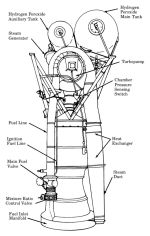
NAA 75-110-A-7,
a Redstone Engine |
After a period of examining and experimenting with captured V-2 rockets, U.S. engineers, sometimes in conjunction with the German engineers and scientists who had immigrated to the U.S., began working on designs of their own. North American Aviation (NAA) developed the XLR-43-NA-1, a LOX/alcohol engine based on V-2 technology for its Navaho cruise missile project. This engine had half the mass and a third more thrust than the V-2 engine; at the end of development its thrust would be nearly double that of the V-2. The complex and costly V-2 combustion chamber, with its 18 thrust chambers, spherical shape, and LOX plumbing maze, was replaced by a flat plate injector and conical combustion chamber. A straight-sided 15° divergent nozzle section was retained. Similar to earlier V-2s, the XLR-43-NA-1 had a turbopump driven by high-pressure steam generated by catalyzing hydrogen peroxide with potassium permanganate in a steam generator. When the Ordnance Guided Missile Center (OGMC) at Redstone Arsenal, Alabama began designing the Redstone missile, it turned to NAA to enhance its XLR-43-NA-1, producing the NAA (Rocketdyne) 75-110 engine series. The designation indicates the engine could produce 75,000 lbT for 110 seconds. |
Abbreviations, Acronyms and Glossary
 |
 |
| The North American Aviation XLR-43-NA-1 (NASA) |
The Rocketdyne 75-110-A-7 |
When the Redstone development team, led by V-2 rocket scientist Wernher von Braun, needed an engine capable of 75,000 lbT, Rocketdyne was asked to modify the XLR-43-NA-1 to meet the new requirements. The new engine was designated NAA 75-110, and the first one was ready for shipment to Redstone Arsenal by the end of July 1953.
Seven different versions (NAA 75-110-A-1 through NAA 75-110-A-7), each with minor differences were produced to support the ongoing missile test program:
- NAA 75-110-A-1: Prototype. Two built, flown in Redstones RS-1 and RS-2.
- NAA 75-110-A-2: LOX pump inducer added to prevent cavitation. Three built, flown in RS-3 to RS-5.
- NAA 75-110-A-3: Five built, flown in RS-8 to RS-12.
- NAA 75-110-A-4: First flown 14 March 1956 on RS-18, first of the Chrysler-built Redstones. Introduced gage pressure thrust control, and later absolute pressure thrust control, as well as first use of Hydyne fuel (60% unsymmetrical dimethylhydrazine (UDMH) and 40% diethylenetriamine (DETA).
- NAA 75-110-A-5: Not flown.
- NAA 75-110-A-6: Flown from 2 October 1957.
- NAA 75-110-A-7: Flown from 24 June 1958.
Redstone Engine
Pneumatic System Simplification
| Component | A-1 Engine | A-7 Engine |
|---|
| Regulators | 4 | 1 |
| Relief Valves | 2 | 1 |
| Solenoid Valves | 12 | 4 |
| Pressure Switches | 6 | 2 |
| Check Valves | 3 | 0 |
| Test Connections | 4 | 1 |
| Pneumatic Filter | 0 | 1 |
| Total | 31 | 10 |
The A-6 and A-7 variants became Redstone missile production engines.
Redstone Engine Components and Functionality
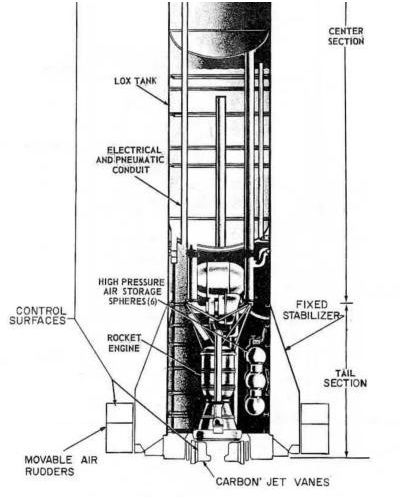 |
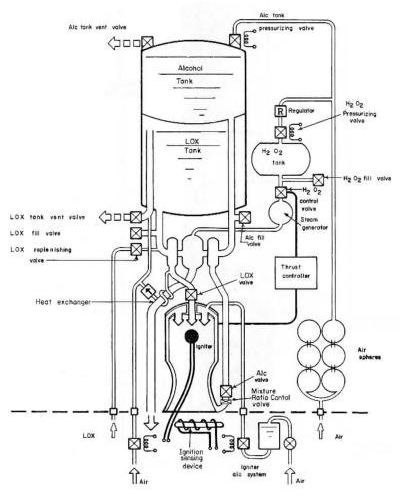 |
 |
| Redstone Thrust Unit (US Army) |
Redstone Propulsion System Functional Schematic (US Army)
Note that ignition fuel is supplied by ground support equipment. |
Redstone Propellent and Hydrogen Peroxide Flow (US Army) |
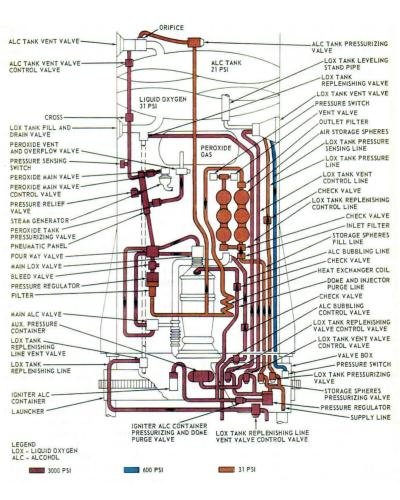 |
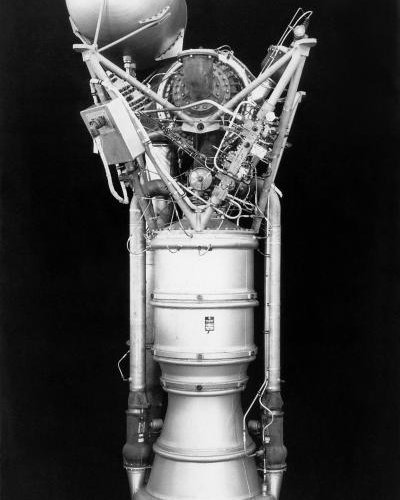 |
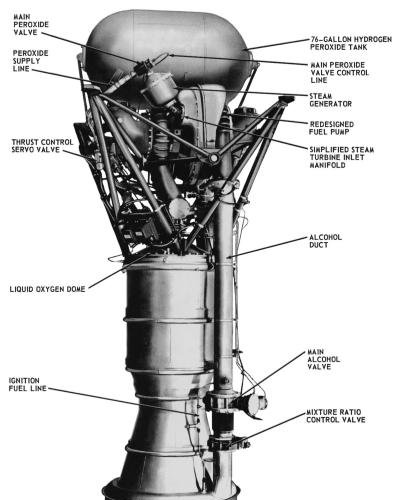 |
Redstone Pneumatic System (US Army)
Note all the ground support systems. |
The NAA (Rocketdyne) 75-110-A-6 had two fuel supply lines.
(heriocrelics.org) |
The NAA (Rocketdyne) 75-110-A-7 had one fuel supply line.
(heriocrelics.org) |
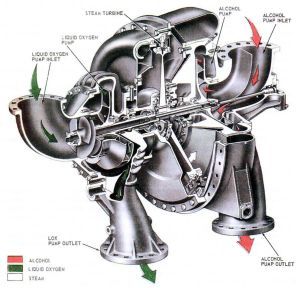 |
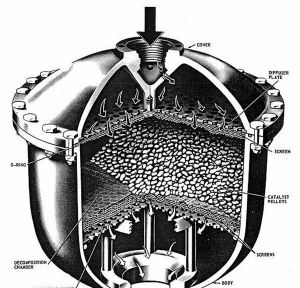 |
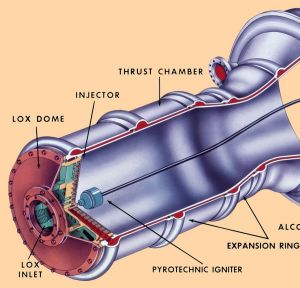 |
T.jpg) |
NAA (Rocketdyne) 75-110-A-7 Turbopump
(US Army) |
NAA (Rocketdyne) 75-110-A-7 Steam Generator
(US Army) |
NAA (Rocketdyne) 75-110-A-6 Thrust Chamber
(heriocrelics.org) |
NAA (Rocketdyne) 75-110 Flat Plate Injector
The inner ring carries starting alcohol from ground support equipment.
Tiny holes in the outermost ring bleed alcohol to shield the combustion chamber and nozzle inner liner from the heat of combustion.
(heriocrelics.org) |
Component Details
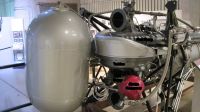 |
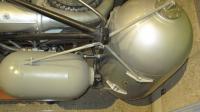 |
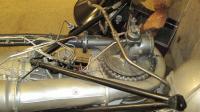 |
 |
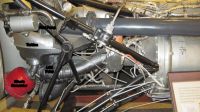 |
| Main Peroxide Tank, Turbopump and Steam Generator (Red) |
Main and Auxiliary Peroxide Tanks |
Alcohol Pump and Heat Exchanger |
Steam Exhaust Duct |
Fuel Pump (Top), Turbine (Center), and LOX Pump (Bottom) |
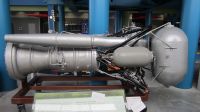 |
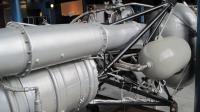 |
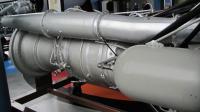 |
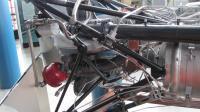 |
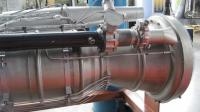 |
| Side View of Engine Steam Side |
View of Engine Steam Side Looking Toward the Top |
View of Engine Steam Side Looking Toward the Bottom |
View of Engine Fuel Duct Side Looking Toward the Bottom |
View of Engine Fuel Duct Side Looking Toward the Bottom |
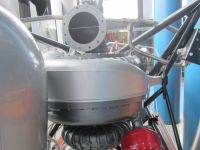 |
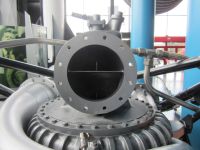 |
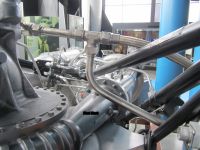 |
 |
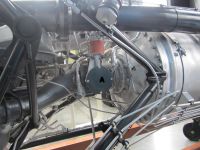 |
| Turbopump Assembly |
Fuel Pump Inlet |
Fuel Pump Outlet |
Main Fuel Valve (A) and
Mixture Ratio Control Valve (B) |
Main LOX Valve (A) |
Redstone Firing Procedure
After the missile was tested, erected, and optically aligned to the True Line of Fire (TLOF, that line over the ground that connects the missile launcher to the target), the final firing preparations were begun. Some of the fueling preparations can be started as soon as the missile was erected. This activity included the connection of various alcohol and LOX lines and valves and the positioning of the fueling ladder. The fire-fighting equipment was in the area during propellant loading operations. The engine cooling jacket was filled with water if the ambient temperature was above 35°F, or lithium chloride if colder, from a container on the alcohol trailer; this permitted a smooth transitional flow of alcohol during engine start. The mixture ratio control valve was also adjusted to compensate for changes in fuel density based on its temperature.
The alcohol trailer was positioned approximately 20 feet from the fueling ladder. The 3.5 quart igniter alcohol container, located in the launcher, was filed by gravity flow from the alcohol trailer emergency valve. The alcohol trailer was connected, through the fueling ladder, to the missile alcohol tank, and the alcohol was pumped into the tank. When the missile alcohol tank was full, the alcohol trailer was disconnected and driven out of the immediate launch area.
LOX Filling was accomplished from two LOX trailers that were simultaneously connected, through a "Y" connection, to the fueling ladder and then to the missile LOX tank. LOX pumping was started from one of the LOX trailers. After a delay of three or four minutes, the pumping of the second LOX trailer (replenishing trailer) was started. This delay was to assure that the depletion of LOX in the second trailer will be less than that of the first, after LOX filling was completed. When the missile LOX tank was full, the LOX pumping operation was stopped and the first LOX trailer was disconnected and driven out of the immediate launching area. The second LOX trailer (the replenishing trailer) was disconnected and moved away from the launcher to a distance of approximately 150 feet. A LOX replenishing line was then connected from the replenishing trailer to the replenishing arm, mounted on the launcher and connected to the missile LOX tank. Periodically, throughout the rest of the operation until missile firing, the normal LOX boiloff from the missile LOX tank will be replaced by the operator of the remote firing box via a replenishing switch.
A hydrogen peroxide truck was positioned near the missile, and the container was connected to the missile hydrogen peroxide tank. The hydrogen peroxide was then pumped into the missile's tank. Upon completion of the hydrogen peroxide filling, the hydrogen peroxide truck was disconnected and driven from the immediate area.
A final vertical range computer check was performed, along with operational status checks of the range guidance computer and the cutoff computer. Upon verification of the in-tolerance operation of the range computer, the presetting information listed on the firing mission data sheet was installed into the cutoff computer. This presetting information included constant values of velocity and displacement, which were compensation for inherent errors peculiar to the individual trajectory of the missile.
A final check of the vertical lateral computer was performed, followed by a warhead prelaunch check, which verified network circuits related to the warhead. The type of warhead burst (air or surface) was also selected at this time.
The guided missile test station was disconnected from the missile system and driven out of the firing area. The powerplant ignition system was readied and the blind plugs, which serve as deactivating or safety devices, were installed. A final check of the missile TLOF was conducted. The immediate firing area was cleared of extraneous equipment and personnel.
The remote firing box operator activated the LOX replenishing switch until LOX tank overflow was visible. At the predetermined time and on order from the Firing Battery Commander, the remote firing box operator closed the firing switch.
Once the firing command was given, the general missile system operating sequence was as follows:
- Missile propellant system vent valves, which were opened for propellant filling, were closed.
- The missile pneumatic system was then utilized to pressurize the propellant tanks. The pressurization of the hydrogen peroxide and alcohol tanks was started immediately upon the firing command signal. When the alcohol tank pressure 21 psi, alcohol tank pressurization stopped and LOX tank pressurization started. Throughout a portion of the flight, propulsion system tanks pressurization cycled because of pressure-sensing switch action.
- When LOX tank pressure reached 31 psi, a pressure switch was actuated to stop the LOX tank pressurization and to start the power transfer sequence. The missile system was operating from ground power until this time in order to save the missile batteries, which were very short-lived under normal loading conditions. During the power transfer sequence, the missile batteries were connected to their respective missile busses, in parallel operation with the ground power sources. When the tie-in was accomplished, the ground power sources were disconnected from the missile system. The operation results in a smooth transition from ground power to missile battery power.
- Completion of the power transfer sequence initiated action to propel the heater-cooler drop tank away from the missile.
- The physical breaking of the electrical connections between the missile and the heater-cooler drop tank actuated the ignition starting sequence. After a slight time delay, which allowed the three missile batteries to settle down under the rather rapid loading action of the power transfer sequence, the igniter squib was fired and ignition took place. During the ignition stage LOX flowed directly from the missile LOX tank due to gravity while the alcohol was obtained under pressure from the igniter alcohol container located on the launcher.
- The mainstage stick link was physically located so as to be burned through by the engine's combustion heat. This resulted in the main alcohol and the hydrogen peroxide flow valves opening in anticipation of thrust buildup. The hydrogen peroxide flowed onto the steam generator catalytic pellets causing a steam buildup which drove the turbopump, which, in turn, drove missile alcohol and LOX into the combustion chamber, where the mixture was burned to produce thrust.
- When the engine thrust developed to the point of overcoming the force of gravity, the missile rose from the launcher. At this point, the flight phases were started and the missile guidance and control system was activated.
- The program device was actuated to begin triggering certain critical electrical circuitry.
- The guidance system stabilized platform lost its earth-fixed reference and became inertially stabilized in space. Any attitude missile deviation from the prescribed trajectory was detected and corrected by the control system.
- The guidance computers were activated to detect and store any missile translational deviations from the desired trajectory.
- The cutoff computer was started and monitored the missile's speed. When the missile reached a predetermined velocity, this computer shut down the propulsion system by cutting off engine propellant flow. The missile was then in the ballistic, or free-falling, phase of its flight.
- Propulsion system shutdown was followed by thrust decay, or burnout of the propellants remaining in the propulsion system downstream of the main propellant valves.
- At a predetermined time, the pulse step switch actuated the separation circuitry, which blew explosive bolts attaching the missile thrust unit to the nose and aft units.
- When nose and aft units reentered the sensible atmosphere, a "Q" switch was actuated. This was the start of the re-entry phase and the end of the ballistic part of the missile flight. The actuation of the "Q" switch also signaled the start of the terminal guidance operation. During the flight, the guidance computers had detected and stored the translational deviations of the missile from the prescribed trajectory. After re-entry, this information was fed to control system in order to direct the missile back toward the prescribed trajectory to assure that the warhead landed within the radial tolerance distance of the target.
Launch Vehicle Engine Specifications
| Engine | Model 39 | Rocketdyne
75-110-A-7 |
| Used In | German V-2 | Redstone |
| Era | 1943 | 1953 |
| Thrust, SL (lb) | 55,000 | 82,977 |
| Thrust, Vac (lb) | ? | 93,565 |
| Burn Time (sec) | 60 | 155 |
| Chamber Pressure (psi) | 218 – 239 | 318 |
| Specific Impulse (sec) | 203 – 239 | 235 – 265 |
| Propellant Flow (gps) | 33.5 | 41.3 |
| Propellant Flow (lb/sec) | 286 | 355 |
| Nozzle Expansion Ratio | 2.83 | 3.61 |
| Engine Weight (lb) | 2,484 | 1.479 |
| Thrust / Weight, SL | 22 | 56 |
| Fuel | 75% Ethanol |
75% Ethanol |
| Oxidizer | LOX | LOX |
| Mixture Ratio (Ox/Fuel) | 1.13 | 1.324 |
| Turbopump Output (hp) | 580 | 758 |
| Turbine RPM | 3,800 | 4,718 |
--- On To Part 5 ---













T.jpg)